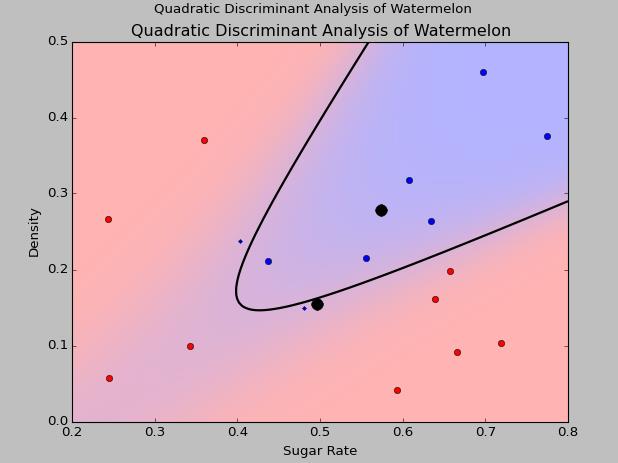《机器学习》周志华 习题答案3.6
Posted 机器人小z
tags:
篇首语:本文由小常识网(cha138.com)小编为大家整理,主要介绍了《机器学习》周志华 习题答案3.6相关的知识,希望对你有一定的参考价值。
原题:线性判别分析仅在线性可分数据上能获得理想结果,试设计一个改进方法,使其能够用于非线性可分数据。
这里我采用二次判别分析来对原来的西瓜数据集进行分类,同样采用sklearn里的二次判别库。
#!/usr/bin/python # -*- coding:utf-8 -*- import numpy as np import matplotlib.pyplot as plt from matplotlib import colors from sklearn.discriminant_analysis import QuadraticDiscriminantAnalysis file1 = open(\'c:\\quant\\watermelon.csv\',\'r\') data = [line.strip(\'\\n\').split(\',\') for line in file1] X = [[float(raw[-3]), float(raw[-2])] for raw in data[1:]] y = [1 if raw[-1]==\'\\xca\\xc7\' else 0 for raw in data[1:]] X = np.array(X) y = np.array(y) #######################################################################以上是西瓜 # colormap cmap = colors.LinearSegmentedColormap( \'red_blue_classes\', {\'red\': [(0, 1, 1), (1, 0.7, 0.7)], \'green\': [(0, 0.7, 0.7), (1, 0.7, 0.7)], \'blue\': [(0, 0.7, 0.7), (1, 1, 1)]}) plt.cm.register_cmap(cmap=cmap) ############################################################################### # plot functions def plot_data(lda, X, y, y_pred): plt.figure() plt.title(\'Quadratic Discriminant Analysis of Watermelon\') plt.xlabel(\'Sugar Rate\') plt.ylabel(\'Density\') tp = (y == y_pred) # True Positive //Boolean matrix tp0, tp1 = tp[y == 0], tp[y == 1] print tp X0, X1 = X[y == 0], X[y == 1] X0_tp, X0_fp = X0[tp0], X0[~tp0] X1_tp, X1_fp = X1[tp1], X1[~tp1] # class 0: dots plt.plot(X0_tp[:, 0], X0_tp[:, 1], \'o\', color=\'red\') plt.plot(X0_fp[:, 0], X0_fp[:, 1], \'.\', color=\'#990000\') # dark red # class 1: dots plt.plot(X1_tp[:, 0], X1_tp[:, 1], \'o\', color=\'blue\') plt.plot(X1_fp[:, 0], X1_fp[:, 1], \'.\', color=\'#000099\') # dark blue # class 0 and 1 : areas nx, ny = 200, 100 x_min, x_max = plt.xlim() y_min, y_max = plt.ylim() xx, yy = np.meshgrid(np.linspace(x_min, x_max, nx), np.linspace(y_min, y_max, ny)) Z = lda.predict_proba(np.c_[xx.ravel(), yy.ravel()]) Z = Z[:, 1].reshape(xx.shape) plt.pcolormesh(xx, yy, Z, cmap=\'red_blue_classes\', norm=colors.Normalize(0., 1.)) plt.contour(xx, yy, Z, [0.5], linewidths=2., colors=\'k\') # means plt.plot(lda.means_[0][0], lda.means_[0][1], \'o\', color=\'black\', markersize=10) plt.plot(lda.means_[1][0], lda.means_[1][1], \'o\', color=\'black\', markersize=10) ############################################################################### # Linear Discriminant Analysis qda = QuadraticDiscriminantAnalysis(store_covariances=True) y_pred = qda.fit(X, y).predict(X) plot_data(qda, X, y, y_pred) plt.axis(\'tight\') plt.suptitle(\'Quadratic Discriminant Analysis of Watermelon\') plt.show()
二次判别分析结果和线性判别分析结果分别如下:


可以看到对于线性不可分数据,二次判别分析的效果非常好。
以上是关于《机器学习》周志华 习题答案3.6的主要内容,如果未能解决你的问题,请参考以下文章